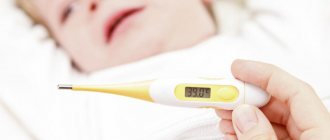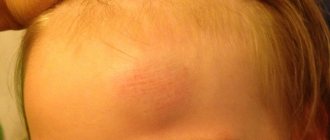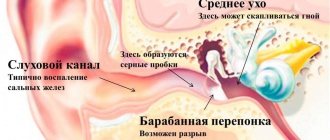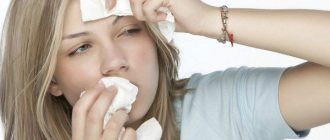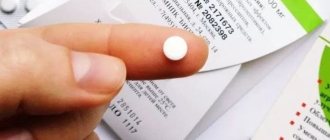When to pierce a child's ears?
The question of at what age is it preferable to pierce a child’s ears causes controversy among experts in various fields and parents.
It is necessary to consider the arguments of followers of early accustoming girls to earrings and supporters of late ear piercing.
Arguments for early piercing
The opinion that piercing is necessary for children under one year of age is held primarily by psychologists. They are convinced that if this procedure is carried out at the age of 6-10 months, the child will experience fewer negative emotions.
With early piercing, negative memories disappear almost instantly, but three-year-old children can return to a stressful situation for a long time and, as a result, may refuse to wear earrings altogether.
Mothers also agree with this opinion, but they mostly pursue aesthetic goals. Their main desire is for those around them to perceive the little princess as a girl, and not confuse her with a boy.
In addition, some parents are convinced that piercing the ears of girls under one year old will help avoid infection of the holes in the ears.
Arguments against early piercing
And yet, many experts oppose ear piercing before the age of three, citing quite reasonable and well-founded arguments. Let's look at them in more detail:
- The ear can take quite a long time to heal, which causes prolonged unpleasant sensations that are not always well tolerated by children under three years of age. The situation is further complicated by the fact that not all medications are approved at such an early age.
- Piercing the ears of a child under three years old often results in the girl trying to pull off the uncomfortable earring. In addition, babies often get their earrings (even if they are very small) caught on their clothes, and this is fraught with pain and bleeding from the wounds.
- Situations are also possible when the lock becomes unfastened and the earring falls out of the earlobe. A girl, interested in a small shiny decoration, can put it in her mouth and, accordingly, swallow it.
- It is also possible that the baby will have an allergic reaction to nickel, which is contained in almost all ear jewelry.
- Another reason not to pierce your ears at an early age is the risk of touching the nerve endings, which are compactly located in the tiny lobe. A similar problem sometimes provokes a delay in the psychological development of girls.
Moms' opinions
A survey was conducted on one popular Russian website, the purpose of which was to find out whether a child’s ears should be pierced, and if so, at what age. Moms' opinions were divided.
- The majority of parents (36%) said that it is possible to tingle the baby’s ears only when the daughter herself asks for it. (Hence, this will be when the child begins to speak, which means later than a year)
- Some mothers (27%) admitted that they have not yet pierced their child’s ears, but have nothing against early piercing.
- 18% of respondents pierced the ears of their children under one year old.
- Another 9% inserted earrings into their daughters aged 1 to 2 years.
- 6% do not intend to prick children’s ears at all and consider it unnecessary and harmful.
- The remaining 4% abstained from answering or suggested some alternative solution.
As for whether a little girl with earrings looks beautiful, mothers also differ in their opinions. Some believe that earrings make their daughters look like little princesses, while others find children with pierced ears ridiculous and funny.
When is it better to pierce a child’s ears: in winter or summer?
Some parents do not pay attention to the time of year, believing that earrings will look attractive on both summer and winter days.
However, if we are talking about a child and his well-being, then all possible factors and conditions should be taken into account. In this case, parents will be able to prevent possible negative consequences.
So, what time of year is best to carry out this procedure? Let's consider the arguments of experts:
- It is not recommended to pierce children's ears in winter. Firstly, they can inadvertently catch a cold. Secondly, the child wears sweaters, turtlenecks, and knitted hats. There is a risk that the baby may catch the earring with threads and damage the ears;
- the first spring and late autumn months are not the best option. The reasons for the undesirability of the procedure in this case are similar to those presented above;
- In summer, you should also not pierce a girl’s ears, since high temperatures and dirty air increase the likelihood of wound infection and help prolong the healing period;
- The best option is May or September. During these periods, temperatures are not as high as in the summer months, and knitted sweaters are not worn. The ears will heal quickly and without any negative consequences.
Thus, in addition to age parameters, it is necessary to take into account the seasonal factor when piercing children's ears. This will avoid negative effects.
Contraindications to the procedure
Despite the desire of parents to pierce the ears of their beloved children, there are a number of conditions and diseases in which it is necessary to either forget about the event for a while or abandon it altogether.
Experts identify the following contraindications (temporary or permanent) to ear piercing:
- some ophthalmological diseases;
- eczematous rashes in the ear area, dermatitis;
- intolerance to nickel alloys;
- blood clotting disorders;
- predisposition to keloid scars;
- diabetes;
- low immunity;
- period of teething;
- reduced pain threshold;
- skin damage in the area of the future puncture;
- moles on earlobes.
It is better not to pierce the ears at all if the child, who is already at a relatively conscious age, is categorically against this procedure.
Probably the refusal is due to fear of the process itself or simply a dislike of earrings. Parents should not insist and use peers as examples. The girl has the right to decide for herself whether she needs such jewelry.
Contraindications for ear piercing
You can't pierce your ears
, If:
- available for metals
- tendency to form cystic acne, which is often localized in the earlobe
- there is a tendency to colloid growths in place, scars
- have skin diseases - eczema,
- blood diseases
- diabetes
- decline
By the way, there is an alternative point of view
that if, when piercing the ear, some important area is accidentally touched, then it will turn off over time, that is, it will not play the important role that nature intended it to play. And supporters of ear piercing use this as an argument for their frivolous attitude towards hanging earrings on the ears. And if only the ears! After all, if sensitivity is lost, another reflexogenic connection will be broken; in their opinion, this is nonsense that is not worth attention, but in fact, this is another step towards their future ill health. Or the ill health of beloved and adored children.
If you decide to pierce your or your child’s ears at any cost, then
- Ear piercing should only be done in special salons or medical institutions, and not on the knee at resorts such as Turkey or Egypt
- Only under sterile conditions and with sterile instruments
- The first thing to insert after ear piercing is sterile nails made of surgical steel or titanium, which are hypoallergenic, gold, and other metals are inserted only a month and a half after the piercing, and then, if the wound did not fester, there was no proliferation of granulomas and local or general ones.
- Although silver is believed to have bactericidal properties, it should absolutely not be inserted until the hole is healed, since it oxidizes in contact with blood and lymph. And silver oxide prevents the rapid healing of the wound.
- For 2-3 weeks, you need to regularly treat the ear piercing site and the studs (earrings) themselves with disinfectant solutions
(boric alcohol, chlorhexidine, miramistin, hydrogen peroxide with boric acid, for purulent discharge - levomekol.
Earrings decorate and add charm to adults and children. Every mother understands how important it is for a girl to be a beautiful princess. Do you have any doubts about when is the best time to pierce your child’s ears? Not only the mother, daughter, but also other family members worry about such an important event. So that the important step takes place without stress and becomes a joyful event for the transformation of the little baby into a feminine lady. Let’s figure out at what age to start the procedure and how to prevent unpleasant consequences.
Experts agree that the decision is up to the parents. Doctors report possible risks and recommend waiting until the age of three, reducing the risk of harming the development of a young body. The fact is that in the auricle, and especially inside the lobes, there are nerve fibers that can be touched. With each passing year of growing up, this risk decreases.
Psychologists believe differently that an unpleasant operation for up to a year will not leave bad memories. It is recommended not to perform surgery for up to 6 months while the immune system develops to avoid infection. Experts report a favorable age of 8-10 months.
On the other hand, relatives advise waiting until they grow up so that the decision can be made independently. Wait for a conscious choice when you can pierce your ears, which happens at any age. The older children are, the more responsibility they take for safety.
The influence of the season on punctures?
There is a belief that when we pierce a child’s ears, we must choose the flowering period of garden apple trees, namely the month of May. Folk experience confirms that at this time there is no suppuration, the wound heals faster. Still, when to pierce your ears? Doctors recommend choosing the beginning of autumn or the last month of spring for earlobe piercing. Due to the lack of dust and heat, there is no need to wear high-neck sweaters or hats like in winter.
Where to pierce a child's ears?
The procedure itself is quite simple, but you need to prepare for it. This is necessary in order to avoid all sorts of undesirable consequences.
The first stage is medical consultations. several specialists with your child
- first of all, you should make an appointment with a pediatrician, who will conduct a general examination and prescribe several diagnostic procedures: a blood test and measuring sugar levels;
- You should also visit an ophthalmologist. The earlobe is closely connected with the organs of vision through a system of nerve fibers. If there are problems with the eyes, it is better to postpone the procedure or refuse it;
- It is also recommended to visit an allergist. Many earrings contain nickel compounds, which can cause hypersensitivity reactions in the body.
The second stage is choosing a medical institution or salon. If there are no contraindications to the procedure, then you need to move on to choosing a salon or clinic.
Is it possible to pierce a child’s ears at a regular hairdresser located nearby? It’s better not to take risks, but to turn to professionals who have documents confirming their qualifications.
An experienced specialist will determine safe places for piercing, carry out the procedure itself as painlessly as possible and guarantee the absence of complications. Parents need to make sure that the instruments and earrings that end up in their children’s ears are sterile.
The third stage is purchasing earrings. Initially, girls are inserted into ears made of a special alloy, which, in fact, pierce the lobes. Then, when the wounds heal, mom will be able to insert other earrings.
We will tell you in more detail further about which jewelry to prefer. It is only important to understand that the hearts should be light, without sharp corners and with a strong clasp that will not open during child manipulation.
Advantages and disadvantages of early ear piercing
Doctors are divided on whether children's ears can be pierced. Some believe that early piercing harms children's ears. Others - mainly psychologists - are of the opinion that under the age of three, a child will survive the stress of a puncture much easier. Who to believe and whose opinion to listen to? Let's try to figure it out. First, let's identify all the pros and cons of early ear piercing.
- As mentioned above, in childhood, children experience the pain of a puncture more easily and quickly forget about negative experiences. In addition, children can be distracted by promising a trip to the circus or the zoo after visiting a cosmetologist.
- If you pierce your ears before the age of 1.5 years, the unpleasant procedure will quickly be forgotten, but if you postpone piercing until an older age, the psychological stress will be stronger. In addition, after the age of 11 years, the risk of developing keloid scars increases significantly.
- Earrings in small children's ears give some girls a touching, angelic look. These little princesses with rhinestones in their ears and blonde curls.
- On the earlobe there are points responsible for vision, hearing and other vital functions of the human body. On a child’s ear, all the points are located as close as possible, which increases the risk of hitting one of them. Need I say that such a mistake by the master will cost you and your child dearly?
- Modern stud earrings, which are usually inserted into the ear immediately after piercing, contain metals that are harmful to children's health. They can cause an allergic reaction in the baby.
- Pediatricians believe that early piercing (before the baby is at least a year old) can be seriously stressful.
- Another “con” of earrings under the age of 3-4 years is that the baby can accidentally catch her hand on the jewelry and tear her earlobe. The same can be said regarding noisy games in kindergarten - girls with earrings in their ears are at great risk.
- If a girl has little hair, then pierced ears will look strange and unaesthetic.
In addition to the advantages and disadvantages described above, contraindications should be mentioned. It is strictly forbidden to pierce the ears of children:
- who have blood diseases;
- who have recently had a cold;
- those suffering from allergies and excessive sensitivity to the alloy materials from which the stud earrings are made.
Ear piercing: main types of procedures, their pros and cons
Another common question that concerns many parents concerns how to properly pierce a child’s ears. There are several options for the procedure: piercing with a special reusable or disposable gun and a special needle.
A specialist decides how to pierce your ears correctly. Parents need to choose the hygiene procedure that is most appropriate for their age and personal characteristics.
Using a special needle
You can pierce a child's ears manually using a special disposable catheter needle. A big plus of such a procedure is the selection of a needle taking into account the size of the earlobe. Also, after piercing, you can put in any earrings, and not just standard “studs” or “rings”.
The procedure itself is quite simple and consists of several steps:
- preliminary disinfection of the auricle on both sides;
- determining the piercing site and marking it with a marker;
- piercing with a disposable needle;
- inserting earrings;
- treating the earlobe with a special healing cream.
Often, the mere sight of a needle causes horror in children; moreover, the procedure itself lasts quite a long time and is somewhat painful. So this method can be recommended to adult girls who are not afraid of medical manipulations.
What else is dangerous about piercing children’s ears: an unconventional view
Many people have heard that the ear contains many points associated with various organs of our body. This knowledge is widely used in reflexology, when an organ is stimulated through these points in order to improve its functioning. In particular, certain parts of the face are projected onto the earlobe: the upper and lower jaw, eyes, palate, inner ear, cheeks and tonsils. Therefore, improper ear piercing can lead to various diseases.
Unsuccessful piercing of the earlobes is especially dangerous due to deterioration of vision: the child may develop conjunctivitis, myopia, or even glaucoma, or existing vision problems will worsen.
With all this, the earlobe is the most suitable place where it is better to pierce: it contains the least active points and there is no cartilage either. But those who want to pierce the ear curl, tragus or cartilage are even more likely to provoke some diseases in their body.
To avoid unpleasant consequences, a child’s ear can be pierced at a “silent” point, which is not a biologically active zone. As a rule, such a point is the anatomical center of the earlobe - each person has its own. This is why it is important to have children’s ears pierced by a competent and experienced specialist.
Choosing earrings for a child
| Decoration Options | When piercing | After the wound has healed |
| Material | Initially, it is better to put earrings made of special medical steel, titanium compounds or bioflex into children’s ears. All these materials are hypoallergenic. | Once the wounds have healed, you can purchase silver or gold earrings. |
| You should not wear them at the time of piercing, since gold contains allergic impurities, and silver oxidizes. | ||
| Form | There are many varieties of earrings for babies. But for the first time it is better to stick to standard small carnations. But the shape of their “head” can be varied: hearts, triangles, balls, etc. | |
| Surface Features | Earrings must be absolutely smooth, the surface without various protrusions, burrs and sharp parts that could scratch the child's skin. | |
| Presence of stones | Small, neat stones (not diamonds, of course, for the safety of the baby) are quite acceptable, especially when it comes to older children. Earrings without stones are also suitable for infants. | |
| Lock type | The ideal option is the same nails with a convenient clasp that a child cannot open on his own or damage. | After healing, you can put on earrings with an English lock that does not squeeze the earlobe. It is also difficult to open with children's hands. |
| Weight | The earrings should be light, otherwise the baby will feel heavy and uncomfortable on her own ears. Naturally, we are not talking about comfortable wearing. |
Caring for pierced ears
Piercing the ears of a small child is only the beginning of a hygiene procedure, since parents will have to regularly treat the ears and monitor possible negative consequences.
The rules of care are quite simple:
- Until the wound hole is completely healed, it is necessary to wipe the ear lobe with antiseptics every day. Hydrogen peroxide, chlorhexidine or miramistin are suitable for this procedure. The usual frequency is three times a day.
- Before processing, the mother should thoroughly wash her hands with antibacterial soap and treat them again with an antiseptic. This will prevent the infectious agent from entering the hole.
- When processing, it is necessary to ensure that the antiseptic gets not only onto the skin surface, but also inside the hole itself. For this purpose, the drug is dripped onto the earring and scrolled 2-3 times in the earlobe.
- Treat wounds with medical glue. In this case, there is no need to twist the earrings; on the contrary, you should touch the wound surface and the earlobes themselves as little as possible.
- If the ears begin to become inflamed, the earlobes need to be treated at least 9 times a day. It is not necessary to remove the earring if the child does not feel pain.
- If pus has formed in the ear, it hurts, the child scratches the auricle, you need to see a doctor and remove the earrings. The doctor will prescribe special antibiotic creams.
- Emergency medical attention may be required if the child gets his earring caught on something and the earlobe breaks. The doctor will probably need stitches.
The wound usually heals within 30 days. After this period, the earrings are removed and treated with an antiseptic. If desired, the jewelry can be changed (they are also treated with peroxide). The earlobe is also lubricated with the drug, and at the end of the procedure the earrings are put back in.
When can a child's ears be pierced? This issue is decided by parents after weighing everything in advance. Some mothers bring their daughter to the salon in the first year of life, while others decide to leave the last word to the girl.
Another question is the choice of the type of procedure. Some specialists pierce ears with special needles, others with a reusable or disposable “shooting” earring instrument. It's up to you to decide!
Serious about ear piercing
Very often the question arises : is it possible and, most importantly, is it necessary to pierce your ears?
Isn't this harmful to health?
After all, there are so many active points on the auricle, the impact of which can seriously affect the entire body as a whole. Learn more about the projections of organs on the auricle and healing ear massage
.
Well, what can you say, a non-professional in his field is really capable of causing more harm than good. And if you pierce your ears anywhere, complications
(loss of sensitivity, imbalance of metabolism, appearance of irritability, disturbances in the functioning of organs, the projections of which were at the puncture site. For example, there were cases when children’s vision deteriorated greatly when, by chance, when the ear was pierced, they fell into the center of vision.
From my point of view, beauty is not worth such sacrifices, but each person decides this question for himself. The main thing is not to rush to pierce a small child’s ear (which many parents suffer from, preoccupied with the external decorations of their child even more than with his health and development of mental abilities). And it’s very, very good to know at least the general contraindications for this procedure.

